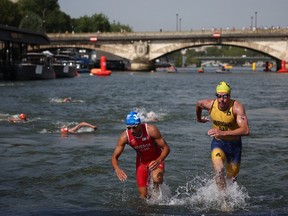Efforts in Paris to clean up the Seine for Olympic swimming events should inspire more investment in Montreal’s urban waterways, expert says.

Article content
France’s ultimately successful efforts to make the waters of the Seine River clean enough for Olympic swimming events may help build necessary public support for the substantial and continuing investments Montreal is making to improve water quality in its surrounding rivers, a local water quality expert says.
France invested the equivalent of CDN$2 billion on projects aimed at cleaning up the Seine in time for Olympic swimming events. For example, during heavy rains, a new, 700-meter-long tunnel now brings overflow from the city’s combined waste and storm sewers into a huge underground storage tank. Together, the tunnel and tank can hold 13.2 million gallons of liquid, enough to fill 20 Olympic pools, so the city’s water-treatment plants can gradually purify all that water before directing it into the river. Paris’s water-treatment facilities now take extra steps, using performic acid and ultraviolet rays to disinfect waste water. And efforts continue in that city to correct mistakes in sewer pipe connections that send untreated household sewage into the river.
Advertisement 2
Story continues below
Article content
The first Olympic event scheduled to be held in the Seine, the swimming portion of the men’s triathlon, had to be postponed by a day because of an earlier rainstorm causing sewer overflows and, therefore, high bacteria counts in the Seine. But by Wednesday, testing showed the bacteria counts were low enough to meet the standards of the World Triathlon Federation, and both the men’s and women’s triathlon swimming events went ahead.
“It was important for there to be a success, because they had made those major investments,” said local water quality expert Sarah Dorner. “To be able to hold the events was important to demonstrate that if you make these investments, you can achieve results.”
Dorner is a professor in the Polytechnique Montréal’s department of Civil, Geological and Mining Engineering, and a co-chair of the Natural Sciences and Engineering Research Council of Canada (NSERC) Industrial Research Chair on Drinking Water. She is involved in research that monitors area beaches and technologies that can be used for rapid methods of detecting fecal contamination.
Article content
Advertisement 3
Story continues below
Article content
She also studies what are known as “blue-green infrastructures,” which are natural solutions to reduce the amount of rainwater that gets into sewers in the first place, to reduce overflows. Sponge parks, which are built lower than street level so they can absorb excess run-off, are one example of these blue-green infrastructures.
“The general consensus is there is a need to have a mix of nature-based solutions and expensive infrastructure solutions because there is not only one solution. With climate change, there is the expectation that it’s not going to be getting better. In fact, it is getting more challenging to retain that excess water from sewer systems. It’s a challenge that is increasing, so the investments have to continue.”
Dorner points out Canada’s standards for waters to be safe for swimming are higher than Europe’s. In Quebec, to be safe for swimming, a waterway should have no more than 200 colony forming units of E.coli per 100 millilitres of water, while the standard for water sports such as canoeing and kayaking is less than 1,000 CFU/100 ml. (E-coli is a bacteria found in the digestive tract of mammals. It is not particularly harmful in itself, but it is an indicator of the presence of other types of pathogenic bacteria.)
Advertisement 4
Story continues below
Article content
Montreal is on an island and the waters surrounding it are clean enough to swim in at most points and on most days of the summer. This has not always been the case. Like Paris, Montreal has invested heavily in retention methods — most recently the Rockfield retention basin in Lachine — to hold contaminated sewer water during heavy rains so it can be treated, rather than dumped into the river.
And, like Paris, Montreal’s waterways have been plagued by the problem of cross-connected sewer pipes, whereby some home builders erroneously connect wastewater pipes to a stormwater sewer pipe, so instead of going to the water-purification plant, the raw sewage ends up in a ditch or stream and, ultimately, the river. Cities and boroughs on the island of Montreal have been involved in a painstaking and expensive effort, called the PLUVIO project, since 2007 to correct these so-called “illicit connections” one by one.
Montreal is also investing heavily in a new technology called ozonation, which treats contaminated water by injecting ozone gas into the wastewater to destroy bacteria, viruses and pharmacological toxins.
Advertisement 5
Story continues below
Article content
First announced in 2008, Montreal’s ozonation plant was projected to take five years to build and cost about $200 million. A city spokesperson told La Presse in November it is now not expected to open before 2028, and its estimated cost is nearing $1 billion. The plant will be built near the Jean-R.-Marcotte water- treatment plant near the northeastern tip of Montreal Island.
Cleaning the rivers is key to continuing access to clean drinking water, improving quality of life and protecting biodiversity, Dorner said. And climate change is making all of those needs more acute.
“When we have these heat waves, what do you do? Where do you go? The public pools are packed. We just don’t have enough spaces to accommodate everybody who needs to cool off. We need spaces close to and within our communities” to swim and cool off, she said.
Recommended from Editorial
Advertisement 6
Story continues below
Article content
Article content



Comments